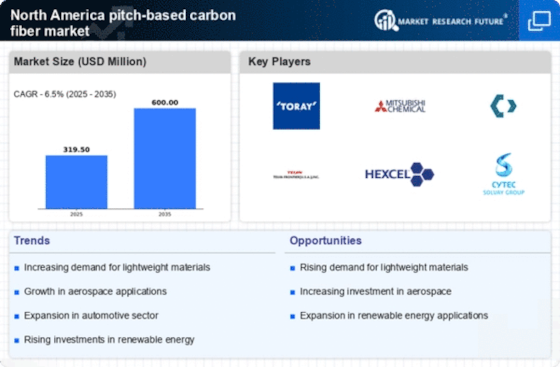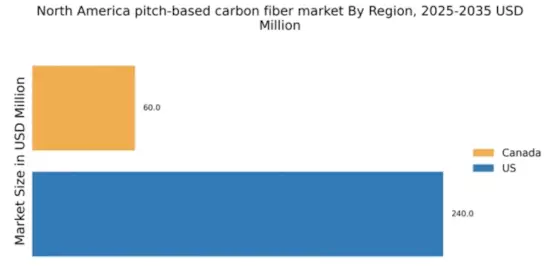Rising Demand from the Energy Sector
The pitch based-carbon-fiber market is witnessing a notable increase in demand from the energy sector, particularly in wind energy applications. The lightweight and high-strength properties of pitch based carbon fibers make them ideal for manufacturing components such as turbine blades. In North America, the wind energy market is expected to grow at a CAGR of around 10% over the next few years, driving the need for advanced materials. This trend indicates a shift towards sustainable energy solutions, where pitch based carbon fibers play a crucial role in enhancing the efficiency and durability of energy systems. Consequently, this rising demand is likely to propel the growth of the pitch based-carbon-fiber market.
Growing Focus on Lightweight Materials
The trend towards lightweight materials is significantly influencing the pitch based-carbon-fiber market. Industries such as automotive and aerospace are increasingly prioritizing weight reduction to improve fuel efficiency and performance. Pitch based carbon fibers, known for their high strength-to-weight ratio, are becoming a preferred choice for manufacturers aiming to meet stringent regulatory standards and consumer demands. In North America, the automotive sector is projected to witness a shift towards lightweight materials, with an expected increase of 20% in the adoption of carbon fiber composites by 2027. This growing focus on lightweight solutions is likely to drive the expansion of the pitch based-carbon-fiber market.
Regulatory Support for Advanced Materials
Regulatory frameworks in North America are increasingly supportive of advanced materials, including pitch based carbon fibers. Government initiatives aimed at promoting innovation and sustainability are creating a favorable environment for the pitch based-carbon-fiber market. Policies that encourage the use of lightweight and high-performance materials in various applications are likely to stimulate market growth. For instance, regulations aimed at reducing carbon emissions in the automotive sector are pushing manufacturers to adopt more efficient materials. This regulatory support not only enhances the market's attractiveness but also encourages investment in the development of pitch based carbon fibers, potentially leading to a more robust market landscape.
Technological Advancements in Manufacturing
The pitch based-carbon-fiber market is experiencing a surge in technological advancements that enhance production efficiency and reduce costs. Innovations in manufacturing processes, such as continuous carbonization and advanced spinning techniques, are enabling manufacturers to produce high-quality carbon fibers at a lower price point. This is particularly relevant in North America, where the market is projected to reach approximately $1.5 billion by 2026. These advancements not only improve the mechanical properties of the fibers but also expand their applicability across various sectors, including aerospace and automotive. As manufacturers adopt these technologies, the overall competitiveness of the pitch based-carbon-fiber market is likely to increase, attracting more investments and fostering growth.
Increased Investment in Research and Development
Investment in research and development (R&D) is a critical driver for the pitch based-carbon-fiber market. Companies are increasingly allocating resources to explore new applications and improve existing products. In North America, R&D spending in advanced materials is projected to increase by approximately 15% annually, reflecting a strong commitment to innovation. This investment not only fosters the development of new manufacturing techniques but also enhances the performance characteristics of pitch based carbon fibers. As a result, the market is likely to benefit from the introduction of novel products that meet the evolving needs of various industries, thereby stimulating growth in the pitch based-carbon-fiber market.


















Leave a Comment